-
Fiber optic cables have revolutionized the telecommunications industry. Using fiber optic cables, telecommunications links realize much higher data rates over much greater distances with lower loss. As a result of these advantages, fiber optic communications systems are widely employed for applications ranging from major telecommunications backbone infrastructure to Ethernet systems, broadband distribution, and general data networking. This article will introduce the most common uses of fiber optic cables.
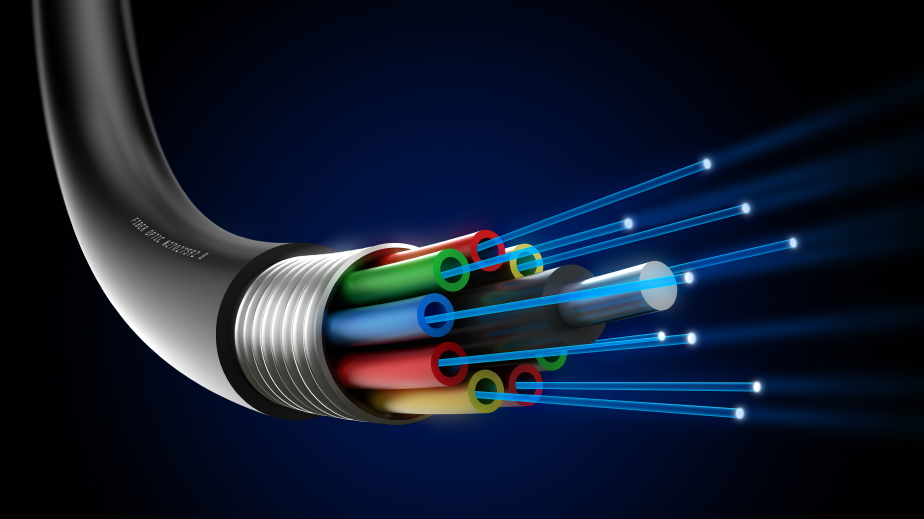
Figure 1: Fiber Optic Cables
Fiber in Computer Networking
Optical fiber can be used as a medium for computer networking, because it is flexible and can be bundled as cables. Compared with electrical cables, light transmission through the fiber has lower attenuation over long distance communications. For short-distance, such as FTTH or FTTO, fiber optic cables can save space in cable ducts. A single fiber can carry much more data than electrical cables such as Cat5 Ethernet cable, which typically runs at 100 Mbit/s or 1 Gbit/s speeds. Besides, fiber is immune to electrical interference. There is no cross-talk between signals in different cables. For these reasons, optical fiber cables have more advantages in computer networking over the electrical cables.
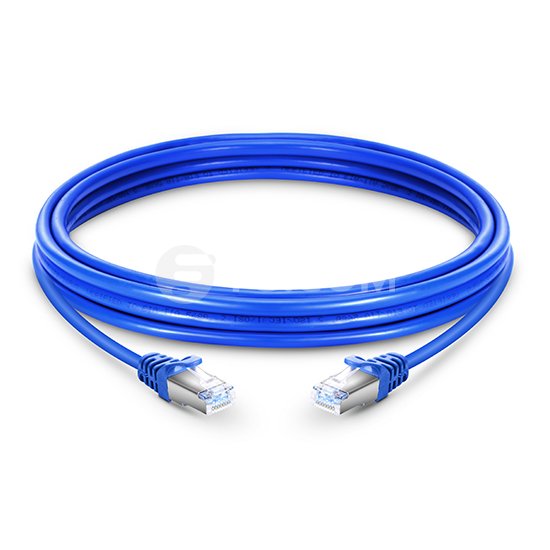
Figure 2: Cat5 Ethernet Cable
Fiber in CATV (Cable Television)
The use of fiber optic cables in the transmission of cable signals has grown explosively over the years. CATV (cable television) services are supplied via a fiber optic network to an optical node, which converts and distributes the electrical signal to subscribers via a coaxial cable connection. Simply, fiber optics is the sending and receiving of data from point-to-point via a network. Cable television companies commonly use fiber for delivery of digital video and data services. These fiber cables are the perfect choices for transmitting broadband signals for high definition televisions, because they have greater bandwidth and speed. Also, fiber optic cables are cheaper as compared to the same quantity of copper wire.
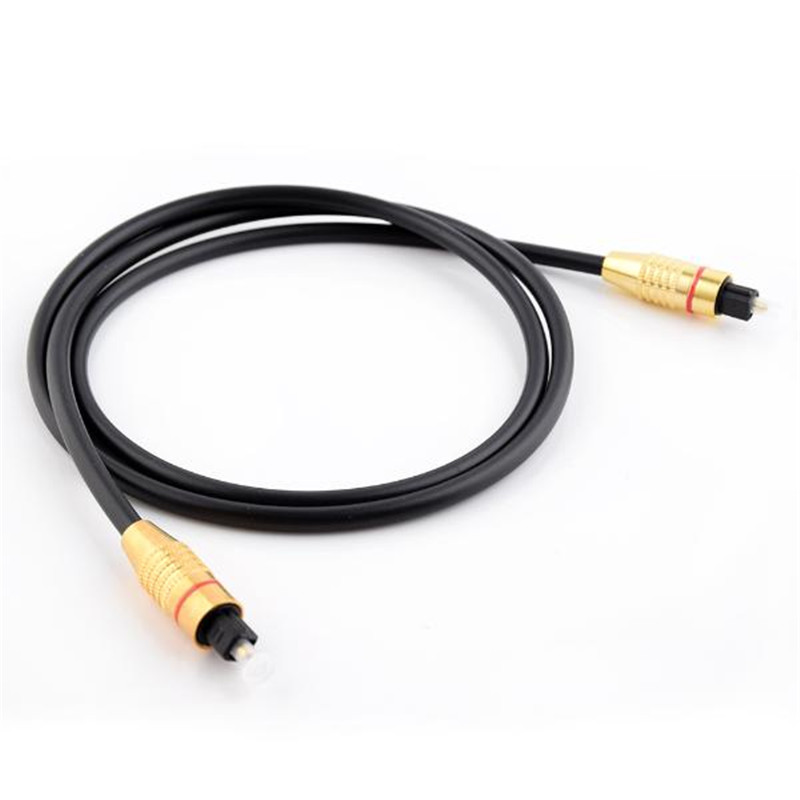
Figure 3: Coaxial Cable
Fiber in Remote Sensing
Optical fibers can be used as sensors to measure strain, temperature and pressure by modifying the fiber counts, in order to modulate the intensity, phase, polarization, wavelength or transit time of light in the fiber. Fiber can be used in remote sensing, because no electrical power is needed at the remote location. Many sensors can be multiplexed along the length of a fiber by using light wavelength shift for each sensor, or by sensing the time delay as light passes along the fiber through each sensor. Besides, fiber optic sensors are immune to electromagnetic interference and do not conduct electricity, so they can be used in places where there is high voltage electricity or flammable material. Generally, polarization maintaining (PM) fiber patch cables are widely used in optical sensor systems.
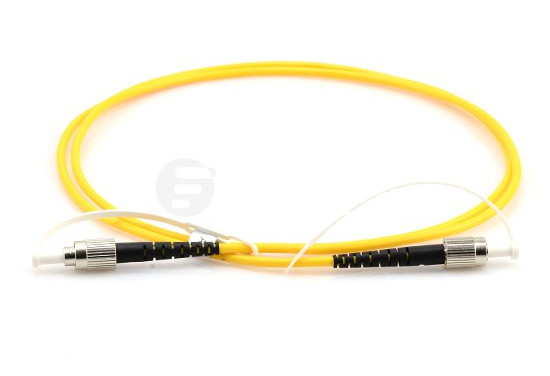
Figure 4: Polarization Maintaining (PM) Fiber Patch Cable
Fiber in Lighting
The use of fiber optics in the area of decorative illumination has grown over the years. Optical fibers are well known as fiberscopes for imaging applications and as light guides for a wide range of non-imaging applications. Currently, optical fibers can be used as light guides where bright light needs to be shone on a target without a clear line-of-sight path. They are widely used for illumination in decorative applications, including signs, art, toys and artificial Christmas trees. For example, Swarovski boutiques use optical fibers to illuminate their crystal showcases from many different angles while only employing one light source. Consequently, more and more application are used fiber for lighting, that is because fiber optic cables provide an easy, economical and attractive solution to lighting projects.
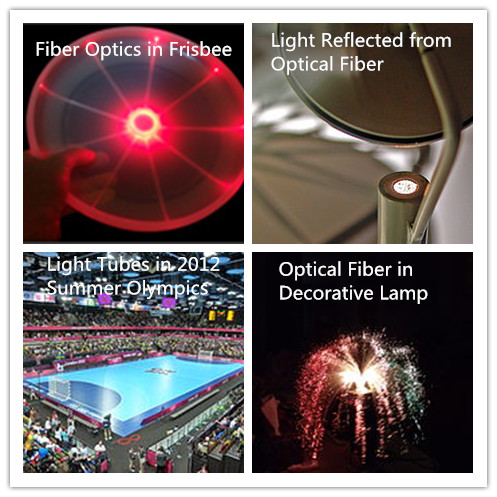
Figure 5: Optical Fiber in Lighting
Fiber in Military
Fiber optic cables are used in a variety of military applications requiring rigorous testing and harsh environment certification to ensure reliability and performance in the field. Military grade fiber optic patch cables are built with specialized military tactical fiber cable that features impact and crush resistance characteristics which comply with military requirements. Additionally, these robust assemblies are rated for operating temperatures of -40ºto +75º Celsius. Three versions are available including Duplex ST, SC and LC styles. These assemblies are excellent for use in military vehicles and with field deployed communications equipment.
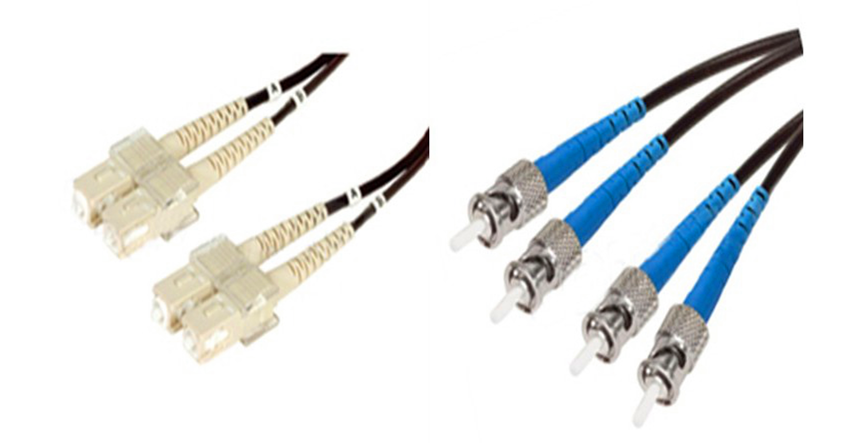
Figure 6: Military Grade Fiber Optic Patch Cable
Conclusion
A huge amount of development can be made by making further research and work on fiber optics. Except what we have discussed, fiber optic cables are also used in biomedical industry, automotive industry, and the fields of medicine, etc. They play a important role in the applications across all industries. It would be the prime demand in the near future.
 your comment
your comment
-
In recent years, it has become apparent that fiber optic cables are steadily replacing copper cables as an appropriate means of signal transmission. A fiber optic cable is a network cable that contains strands of glass fibers inside an insulated casing. It is designed for long distance and high performance for data networking and telecommunications. This article will make a comparison between fiber optic cable and copper cable, which can help customers make an educated choice about cabling options.

Figure 1: Fiber Optic Cable VS. Copper Cable
Transmission Media
A fiber optic system is similar to the copper cable system. The difference is that optical fiber use light pulses to transmit information instead of using electronic pulses (copper cable) to transmit information. Photons used in fiber optic cable travel at the speed of light, whereas electrons used in copper wire travel at less than one percent of the speed of light in nature. Though fiber optic cables don’t travel at the speed of light, they are just slower about 31 percent. So the transmission media of fiber optic cable supports higher transmission speed than copper cable.
Attenuation
Both fiber and copper will experience a loss of signal in long cable runs. However, when traveling over a long distance, fiber optic cables experience less signal loss than copper cabling, known as low attenuation. Research shows that fiber loses only 3 percent signal when going over 100 meters (320 feet) in distance. By contrast, copper loses 94 percent over the same distance. Repeaters or boosters can improve those rates, but fiber retains a higher bandwidth over greater distances than copper. In a word, fiber optic cable experiences less signal loss at great distances than copper cable.

Figure 2: OS2 Single-mode Fiber Patch Cable
Electromagnetic interference
Because copper cables operate through electrical signals, they can be prone to the effects of electromagnetic interference (EMI) from lightning, nearby power lines or RFI radio signals. Besides, if not properly installed, copper wires will produce electromagnetic currents that can interfere with other wires and decrease the network performance. However, fiber optic cable can not be affected by the external magnetic field. Fiber is a dielectric, which means that no electrical current flows through it. So it is resistant to fire and electromagnetic interference. Generally speaking, fiber is more resilient to the environmental factors that can affect copper cable, so data transmission through fiber is slightly more reliable. In short, fiber optic cable is more resilient to EMI than copper cable.
Cost
Is copper cheaper than fiber? There is no clear answer, as there are many different scenarios to consider. As a general rule, fiber optic cable is 1-5% more in cost than copper cable. However, the long-term effect of a choice have to be weighed against immediate costs. The growing demand for fiber cables is resulting in dropping prices. What’s more, many organizations are being converted to fiber. The reason is that fiber optic cable is greater capacity and longer distance in transmission. Fiber optic cable gives the providers greater reliability and flexibility. With an optimized network fiber system, you can take advantages of fiber’s strengths. On the other hand, copper just costs less at the beginning, it will be more expensive than fiber over the lifetime of the installation, maintenance costs and downtime. We may make a conclusion that fiber optic cables become more cost effective in larger applications; on a small scale, for home networks or small office network, copper cable remains the best option and most cost effective. All in all, fiber optic cable costs lower than copper cable in the long term.
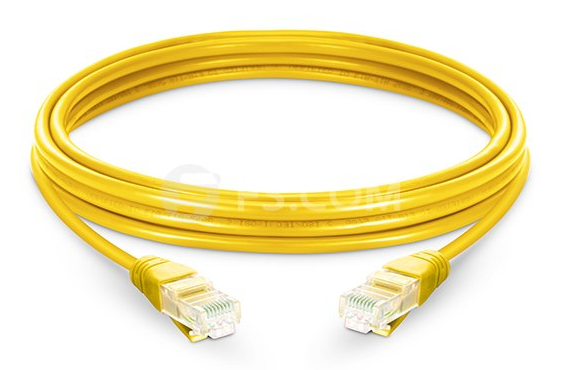
Figure 3: Cat5e UTP Patch Cable
Installation
Copper cables are quite fragile and have a lower tension limit than fiber cable, which may make copper installations slightly more complicated. Fiber is lighter than copper, which means it’s easier to pull and install. Because of its dielectric, there’s no need to worry about EMI and the proximity to power cables. For this reason, fiber optic cable is more easily installed than copper cable.
Conclusion
A comparison between fiber optic cable and copper cable has been presented. The invention of fiber-optic technology is a revolutionary departure from the traditional copper cable. With the fiber optic systems being used in the backbone applications of most major companies, there is no doubt that fiber optic technology will be continuously researched and expanded to cater for future demands. So in the long term, fiber optic cable will offer more advantages than copper cable.
 your comment
your comment
-
With the advent of big data, the data center landscape is changing rapidly. There are an increasing amount of high density, high bandwidth applications on the market. At this point, the passive cable or copper cable system are in the cart. Active optical cables (AOCs), as the main transmission medium in high performance computers (HPCs) and data centers ensures the stability and flexibility of transmission. Active Optical Cable (AOC) is used for short-range multi-lane data communication and interconnect applications. This article will introduce the basis and applications of AOC cables, and analyze the advantages of AOC cables from the buyer perspective.
What Is an AOC Cable?
AOC cable is a cabling technology that accepts same electrical inputs as a traditional copper cable, but uses optical fiber “between the connectors”. AOC uses electrical-to-optical conversion on the cable ends to improve speed and distance performance of the cable without sacrificing compatibility with standard electrical interfaces. In general, AOCs are used for short interconnection (100-200 meters) as the cost-effective alternative solution. They are widely used in high performance computers (HPCs) and hyperscale, enterprise and storage systems.
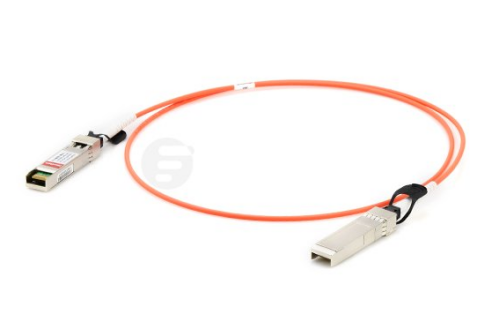
AOC Cable Advantages from the Buyer’s Perspective
An AOC cable uses two optical transceivers with integrated fiber. So, what on earth are the differences between AOC and optical transceiver? And what are AOC advantages over the optical transceivers? We will talk about these question from the buyer perspective.
Firstly, AOC is a “plug and play” cable solution rather than a “plug, assemble and clean” solution as with optical transceivers. Therefore, AOCs do not have optical connectors to manually clean, as a single speck of dust inside the connector can completely block the 50-um or 9-um diameter fiber light transmission. On the other hand, an optical transceiver has two fiber ends and two transceiver ends to clean. Besides, the personnel cost of the connector cleaners can cost upwards of $250 each and stocked.
Secondly, there are big operational power cost savings. AOCs consume 2.2Watts per end compared to 2.8-4.5W for optical transceivers, because AOCs are less complex than optical transceivers and offer lower power consumption.
Last but not least, AOC cables have a short bend radius and much thinner able thickness than most DAC cables. This makes them easier to deploy and frees up a lot of space for increased air flow cooling in crowded systems.
All in all, AOCs have the lowest optical power consumption, and there is no optical connectors to clean and maintain. Both of these two elements can save the operating expenses and increases reliability.
How Are AOCs used in Modern Data Centers?
Because of the power and cost savings, AOCs have become a popular way to link Top-of-Rack switches upwards to aggregation layer switches. Additionally, AOCs are also used in storage subsystems and some hyperscale builders who often run 10G or 25G AOCs from a Top-of-Rack switch to subsystems at reaches greater than DAC limits of 3-7 meters.
Figure 1 is an example of how AOCs are typically used inside systems racks to link subsystems together and between switches and systems:
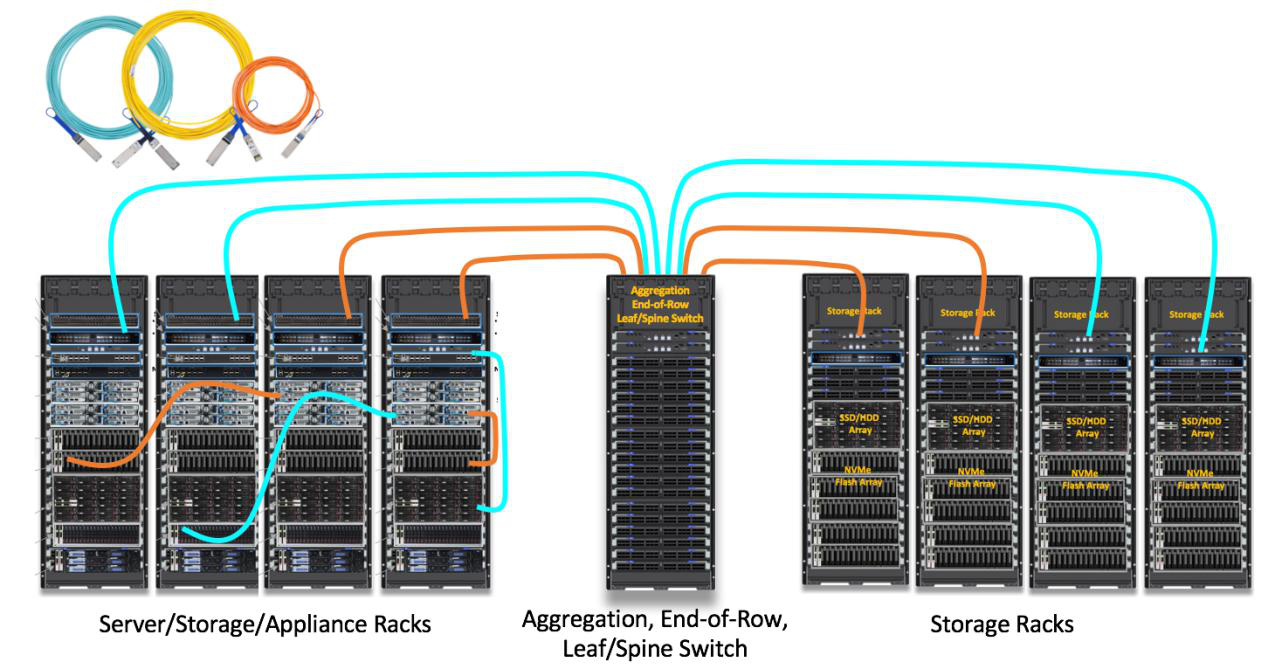
Figure 1: Typical applications of AOCs
Here is a more detailed view in Ethernet configurations showing the 40Gb/s based AOCs and Cisco switches.
As a high performance integrated cable, AOCs can provide protection from environmental pollutants and other user trouble during installation. Figure 2 shows one Cisco 40 QSFP+ to QSFP+ AOC cable connected by two switches directly.

Figure 2: One Cisco 40 QSFP+ to QSFP+ AOC Cable Connected by Two Switches Directly
For the long haul transmission between the two Cisco switches, figure 3 shows a suggested suitable solution by using single-mode patch cable and OEO Converters. The two QSFP to QSFP 40G OEO Converters which are connected by 40G transceivers, can provide seamless integration of different fiber types by converting multi-mode fiber to single-mode fiber.

Figure 3: Cisco 40GbE QSFP+ to QSFP+ AOC Interconnection Solution
Conclusion
Compared with the traditional cable, AOC has the advantages of high transmission rate, long transmission distance, low energy consumption, easy to use and so on. It can help the communication equipment enjoy the great advantage of optical transmission. It is ideal for data center and consumer electronics of the transmission cable.
 your comment
your comment
-
When transmitting data or conducting power in harsh environments, protecting your cables is crucial to safe and reliable operation. This is why armored cables come into being. Armored fiber optic cable refers to the robust construction of the inner core and jacket. It utilizes an interlocking armored design to eliminate the installment of rigid conduit required by building codes. The armor provides added protection for installation in high traffic areas where security is required. It is ideal for industrial networking applications.
The Construction of Armoured Cable
Armored patch cords are constructed with a helical stainless steel tape over a buffered fiber surrounded by a layer of aramid and stainless steel mesh with an outer jacket. This will help make the armored fiber patch cord resistant of high tension and pressure. It can resist the weight of an adult person, and it is not easy to break when bent or dragged. The inside armored can protect the whole cable from rodent. The armored tube provides additional protection where mechanical stress has the potential to cause damage to the cable, such as direct burial, outdoors or underground. It also enables the cable to bear higher pulling loads.

Armored Patch Cable VS. Standard Patch Cable
First, resistance of damage and rodent bite. The biggest difference between armored patch cable and standard patch cable is that the armored patch cables are easy to use in harsh environment. In fact, armored fiber optic cables retain all the features of standard patch cords, but they are much more stronger. The armored fiber optic cables will not get damage even it is stepped by an adult. And they are anti-rodents, people do not need to worry that the rodent animals like the rats may bite the cables and make them broken.
Second, excellent elasticity and light weight. Armored fiber optic cables are light weight and flexible with about an 8 inch bend radius. Due to the excellent elasticity metallic tube, they have the max bending radius and strong tensile strength. All of these make them prolong the service life and be easy to install.
Third, lower insertion loss and higher return loss. Insertion loss and return loss are two important data to evaluate the quality of many passive fiber optic components. Maximum acceptable fiber patch cable insertion loss is usually 0.35 dB, while the return loss should be more than 50dB. Basically, armored patch cables have lower insertion loss and higher return loss than standard patch cables, so they can provide more stable transmission.
All in all, armored fibre optic cables are designed in harsh environment, including environments with excessive dust, oil, gas, moisture, or even damage-causing rodents. They can provide stronger protection of the optical fibers than standards fiber optic cables. Moreover, the installation procedure and maintenance are also easy. They are ideal choice for people who is looking for fiber optic patch cords with additional durability and protection as well as light weight.

FS Armored Patch Cable Solutions
FS provides an extensive line of high performance armored fiber assemblies. Available in a variety of configurations including OS2, OM1, OM2, OM3, and OM4 fiber along with common connectors such as the LC, SC, FC, and ST. These fiber cables are the perfect options to any fiber network in hazardous environments, they can provide flexible interconnection to active equipment, passive optical devices and cross-connects.
Ordering information:
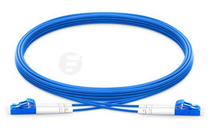
Armored OS2 9/125 Singlemode 3mm OS2
Laser Optimized fiber with 3.0mm cable diameter is perfect for 10G, 40G and 100G higher bandwidth application.

Armored OM4 40/100Gb 50/125 MMF OM4
Laser Optimized fiber with 3.0mm cable diameter is perfect for 10G, 40G and 100G higher bandwidth application.

Armored OM3 10Gb 50/125 Multimode OM3
Laser Optimized fiber with 3.0mm cable diameter is perfect for 10G, 40G and 100G higher bandwidth application.

Armored OM1/OM2 Multimode
62.5/125 μm fiber with 3.0mm cable diameter with 3.0mm cable diameter designed for Fast Ethernet, Gigabit Ethernet and Fiber Channel application
The products above are just four major categories we offer. We provide armored fiber optic patch cables with any connector configuration in single-mode or multimode and in any length you need. What’s more, if you have some customized requirements, you can give us a call or e-mail us to get a quote on custom armored patch cables.
Conclusion
FS’s armored cables offer distinct advantages and deliver maximum performance and ease of installation for a broad range of commercial, industrial and utility applications. Featuring aluminum interlocked armor, FS’s armored cables demonstrate excellent crush, heat, moisture and chemical resistance to meet the requirements of harsh industrial conditions and hazardous locations.
 your comment
your comment
-
As data traffic increases, the requirements for high-bandwidth equipment also continue to rise. Many IT departments are looking towards devices like the 100G QSFP28 transceiver to achieve rapid data transmission. This small, high-density and high-speed product often comes as a standard part of 100G equipment. Therefore, these 100G optical transceivers have become the vital components in data centers. In this article, we will talk about the basic types of 100G QSFP28 optical transceivers, including SR4, PSM4, CWDM4 and LR4 versions.
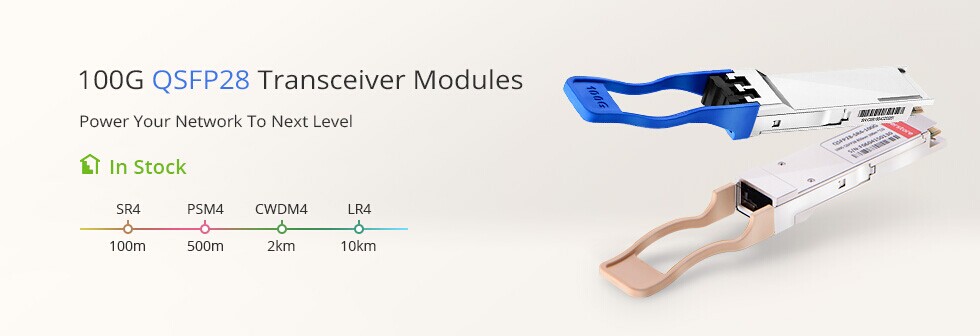
QSFP28 Delivers Greater Benefits to Customers
QSFP28 optical transceiver, designed in 100 Gb/s Ethernet network, which can provide high performance at low power. Firstly, these QSFP28 transceivers are fully compliant with all the latest Fibre Channel and Ethernet standards. And they have very high volumes, because it supports both 100G and 25G links. They allow maximum network capacity and help you quickly migrate to 100G transmission. Also, QSFP28 module is the smallest module available, and has the lowest power consumption among those that are capable of handling 100G traffic. So overall, these compact, high-density and high-speed modules can help to reduce the footprint of servers and lower power consumption while enabling more rapid data transmission.
FS 100G QSFP28 Family
FS has a wide range of 100G modules so that users can extend their choices when selecting a QSFP28 transceiver. These transceiver types include QSFP-100G-SR4-S, QSFP-100G-PSM4-S, QSFP-100G-CWDM4-S and QSFP-100G-LR4-S. And you can choose different brands of these types, covering Cisco, Juniper, Arista, Brocade, Extreme, Dell, Huawei, Ciena and Generic Compatible.
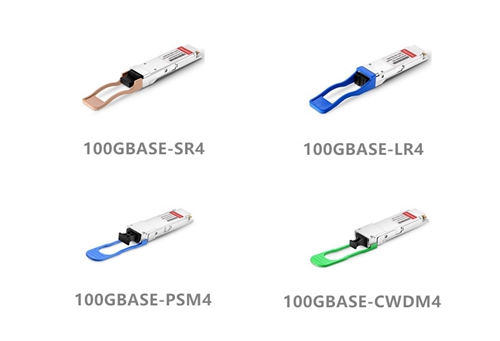
QSFP-100G-SR4-S: The SR4 version supports 100G Ethernet up to 70m on OM3 MMF and up to 100m on OM4 MMF. This 100G QSFP28 SR4 full-duplex optical module offers 4 independent transmit and receive channels, while each offers 25Gb/s operation for an aggregate data rate of 100Gb/s on 100 meters of OM4 multi-mode fiber. An optical fiber ribbon cable with an MTP/MPO connector can be plugged into the QSFP28 module, while electrical connection is achieved through an MSA-compliant 38-pin edge type connector.
QSFP-100G-PSM4-S:The PSM4 version is targeted to service the need of a parallel single mode infrastructure, as most customers currently pursue to the low cost solutions at 500m reach. The PSM4 offers 100G link length up to 500m. This 100G QSFP28 PSM4 defines a four lane 100 Gb/s optical interface to SMF media. Four identical and independent lanes are used for each signal direction. Moreover, the 100G PSM4 transceiver module provides a bi-directional electrical interface with the Host and a bi-directional optical interface with the fiber media. It performs transmit and receive functions that convey data between the Host and the media. All in all, the 100G PSM4 module define requirements for a point-to-point 100 Gb/s link over eight single-mode fibers up to at least 500 m.
QSFP-100G-LR4-S: The LR4 version supports connections up to 10km over single-mode fiber at a wavelength of 1310nm with duplex LC connectors. QSFP-100G-LR4-S supports 100GBase Ethernet rate up to 1km, and the signal is carried over four wavelengths managed within the device. The module converts 4 input channels of 25 Gbps electrical data to 4 channels of LAN WDM optical signals and then multiplexes them into a single channel for 100 Gbps optical transmission. Correspondingly, on the receiver side, the module de-multiplexes a 100 Gbps optical input into 4 channels of LAN WDM optical signals and then converts them to 4 output channels of electrical data. Besides, 100G QSFP28E-LR4 incorporates the electro-absorption modulated lasers (EML), EML have slightly different optical properties making them suitable for multi-rate traffic types.
QSFP-100G-CWDM4-S: The QSFP-100G-CWDM4-S optical transceiver is a full duplex optic module that provides a high-speed link at aggregated data rate of 103.13 Gbps over 2 km of single-mode fiber with duplex LC connectors. CWDM4 modules have the following common features: four optical transmitters, four optical receivers with signal detect,wavelength division multiplexer and de-multiplexer and a duplex optical connector for single-mode fiber. The transceiver four lasers with center wavelengths of 1271 nm, 1291 nm, 1311 nm and 1331 nm. The optical signals are then multiplexed into a single-mode fiber through an industry standard LC connector. On the receive side, four lanes of optical data streams are optically de-multiplexed by an integrated optical demultiplexer and transformed to an electrical CAUI-4 compliant output driver. This module features a hot-pluggable electrical interface, low power consumption and 2-wire I2C management interface.

All versions are fully compliant with the MSA standards and digital diagnostics functions are available via an MDIO interface, as specified by the QSFP28 MSA. These units operate off a single 3.3V power supply, and feature maximum power consumption of 3.5W (CWDM4, SR4, PSM4), or 4.5W/4.0W (LR4).
Conclusion
This next-generation QSFP28 provides increased port density and high performance for future data center and networking use. Most importantly, they can save you total expenditure in your date centers. For cost-sensitive data center customers, you can take your network to the next level with FS 100G QSFP28 optical transceivers, which offer easy compatibility with your existing switches and routers.
 your comment
your comment




